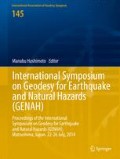Abstract
Rapid subsidence had been observed along the Pacific coast of northeast Japan and the 2011 M w 9.0 Tohoku-oki earthquake caused additional subsidence over 1 m. On the other hand, geomorphological evidence shows the same area is slightly uplifting in a long-term. In order to interpret this paradoxical vertical movement, we construct a simple model of earthquake deformation cycle. Viscous relaxation in the asthenosphere can significantly affect crustal deformation pattern over an earthquake cycle. When earthquake recurrence interval is longer than the asthenospheric relaxation time, temporal variation in the interseismic deformation pattern becomes significant. Spatially heterogeneous behavior in earthquake recurrence may be responsible for the enigmatic vertical movement in northeast Japan.
Access this chapter
Tax calculation will be finalised at checkout
Purchases are for personal use only
References
El-Fiky GS, Kato T (1999) Interplate coupling in the Tohoku district from geodetic data inversion. J Geophys Res 104:20361–20377
Han S-C, Sauber J, Pollitz F (2014) Broadscale postseismic gravity change following the 2011 Tohoku-Oki earthquake and implication for deformation by viscoelastic relaxation and afterslip. Geophys Res Lett 41. doi:10.1002/2014GL060905
Hashimoto C, Fukui K, Matsu’ura M (2004) 3-D modeling of plate interfaces and numerical simulation of long-term crustal deformation in and around Japan. Pure Appl Geophys 161:2053–2068
Hashimoto C, Noda A, Sagiya T, Matsu’ura M (2009) Interplate seismogenic zones along the Kuril-Japan trench inferred from GPS data inversion. Nat Geosci 2:141–144
Headquaters for Earthquake Research Promotion (2003) Evaluations of occurrence potentials of earthquakes off Sanriku-Boso area (version 2). http://www.jishin.go.jp/main/chousa/11nov_sanriku/sanriku_boso_4_hyoka.pdf
Ikeda Y (2003) Discrepancy between geologic and geodetic strain rates (in Japanese). Gekkan Chikyu 25:125–129
Kanamori H, Miyazawa M, Mori J (2006) Investigation of the earthquake sequence off Miyagi prefecture with historical seismographs. Earth Planets Space 58:1533–1541
Kita S, Okada T, Hasegawa A, Nakajima J, Matsuzawa T (2010) Anomalous deepening of a seismic belt in the upper plane of the upper-plane of the double seismic zone in the Pacific slab beneath the Hokkaido corner: possible evidence for thermal shielding caused by sub ducted forearm crust materials. Earth Planet Sci Lett 290:415–426
Koike K, Machida H (2001) Atlas of quaternary marine terraces in the Japanese islands (in Japanese). University of Tokyo Press, Tokyo, 105 pp.
Matsu’ura M, Sato T (1989) A dislocation model for the earthquake cycle at convergent plate boundaries. Geophys J Int 96:23–32
Mazzaotti S, Le Pichon X, Henry P, Miyazaki S (2000) Full interseismic locking of the Nankai and Japan-west Kurile subduction zones: an analysis of uniform elastic strain accumulation in Japan constrained by permanent GPS. J Geophys Res 105:13159–13177
Murakami M, Ozawa S (2004) Mapped vertical deformation field of Japan derived from continuous GPS measurements and its tectonic implications (in Japanese with English abstract). Zisin 57:209–231
Nakajima J, Hasegawa A (2006) Anomalous low-velocity zone and linear alignment of seismicity along it in the sub ducted Pacific slab beneath Kanto, Japan: reactivation of sub ducted fracture zone? Geophys Res Lett 33. doi:10.1029/2006GL026773
Nishimura T, Hirasawa T, Miyazaki S, Sagiya T, Tada T, Miura S, Tanaka K (2004) Temporal change of interpolate coupling in northeastern Japan during 1995–2002 estimated from continuous GPS observations. Geophys J Int 157:901–916
Ozawa S, Nishimura T, Suito H, Kobayashi T, Tobita M, Imakiire T (2011) Coseismic and postseismic slip of the 2011 magnitude-9 Tohoku-Oki earthquake. Nature 475:273–277
Savage JC, Prescott WH (1978) Asthenosphere readjustment and the earthquake cycle. J Geophys Res 83:3369–3376
Schwartz SY, Rokosky JM (2007) Slow slip events and seismic tremor at circum-Pacific subduction zones. Rev Geophys 45. doi:10.1029/2006RG000208
Sun T, Wang K, Iinuma T, Hino R, He J, Fujimoto H, Kido M, Osada Y, Miura S, Ohta Y, Hu Y (2014) Prevalence of viscoelastic relaxation after the 2011 Tohoku-oki earthquake. Nature 514:84–87. doi:10.1038/nature13778
Suwa Y, Miura S, Hasegawa A, Sato T, Tachibana K (2006) Interplate coupling beneath NE Japan inferred from three-dimensional displacement field. J Geophys Res 111. doi:10.1029/2004JB003203
Tse ST, Rice JR (1986) Crustal earthquake instability in relation to the depth variation of frictional slip properties. J Geophys Res 91:9452–9472
Wang R, Lorenzo-Martin F, Roth F (2006) PSGRN/PSCMP–a new code for calculating co- and post-seismic deformation, geoid and gravity changes based on the viscoelastic-gravitational dislocation theory. Comput Geosci 32:527–541
Watanabe S, Sato M, Fujita M, Ishikawa T, Yokota Y, Ujihara N, Asada A (2014) Evidence of viscoelastic deformation following the 2011 Tohoku-Oki earthquake revealed from seafloor geodetic observation. Geophys Res Lett. doi:10.1002/2014GL061134
Yoshioka S, Suzuki H (1999) Effects of three-dimensional inhomogeneous viscoelastic structures on post-seismic surface deformations associated with the great 1946 Nankaido earthquake. Pure Appl Geophys 154:307–328
Acknowledgements
Critical comments from three anonymous reviewers were helpful in improving the manuscript. This work was supported by JSPS KAKENHI Grant Number 22540437 and 25282111.
Author information
Authors and Affiliations
Corresponding author
Editor information
Editors and Affiliations
Rights and permissions
Copyright information
© 2015 Springer International Publishing Switzerland
About this paper
Cite this paper
Sagiya, T. (2015). Paradoxical Vertical Crustal Movement Along the Pacific Coast of Northeast Japan. In: Hashimoto, M. (eds) International Symposium on Geodesy for Earthquake and Natural Hazards (GENAH). International Association of Geodesy Symposia, vol 145. Springer, Cham. https://doi.org/10.1007/1345_2015_189
Download citation
DOI: https://doi.org/10.1007/1345_2015_189
Published:
Publisher Name: Springer, Cham
Print ISBN: 978-3-319-39767-2
Online ISBN: 978-3-319-39768-9
eBook Packages: Earth and Environmental ScienceEarth and Environmental Science (R0)

